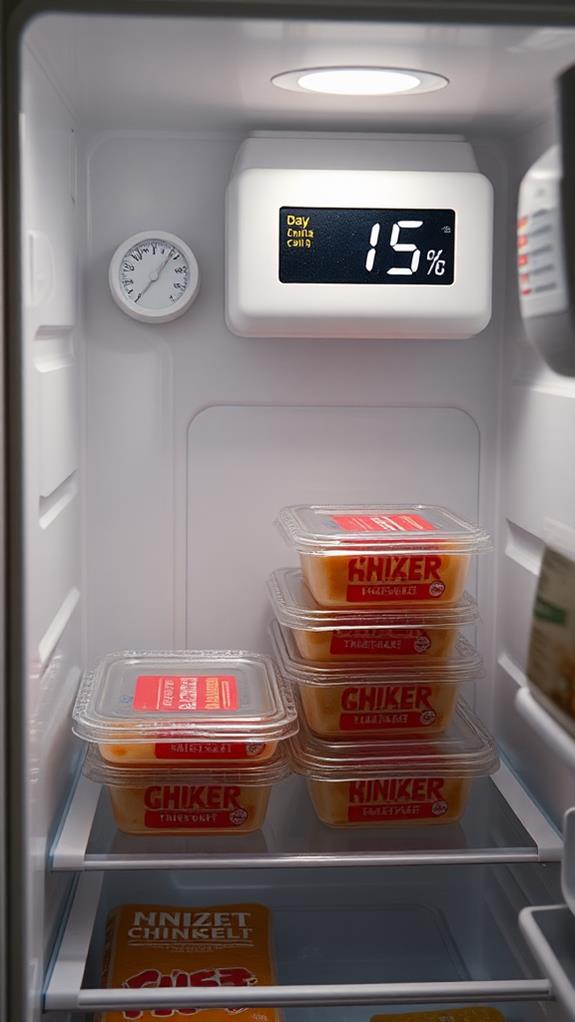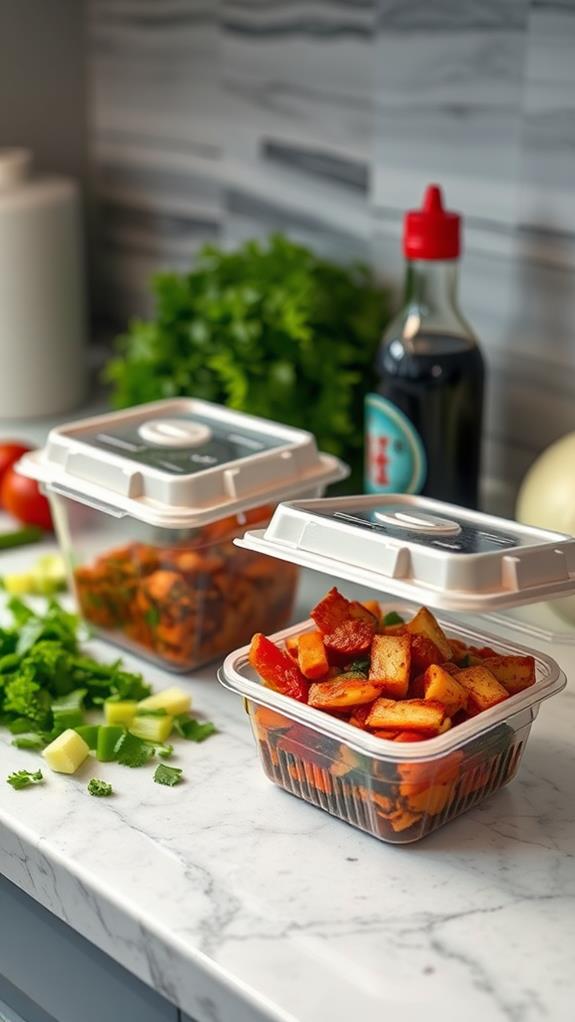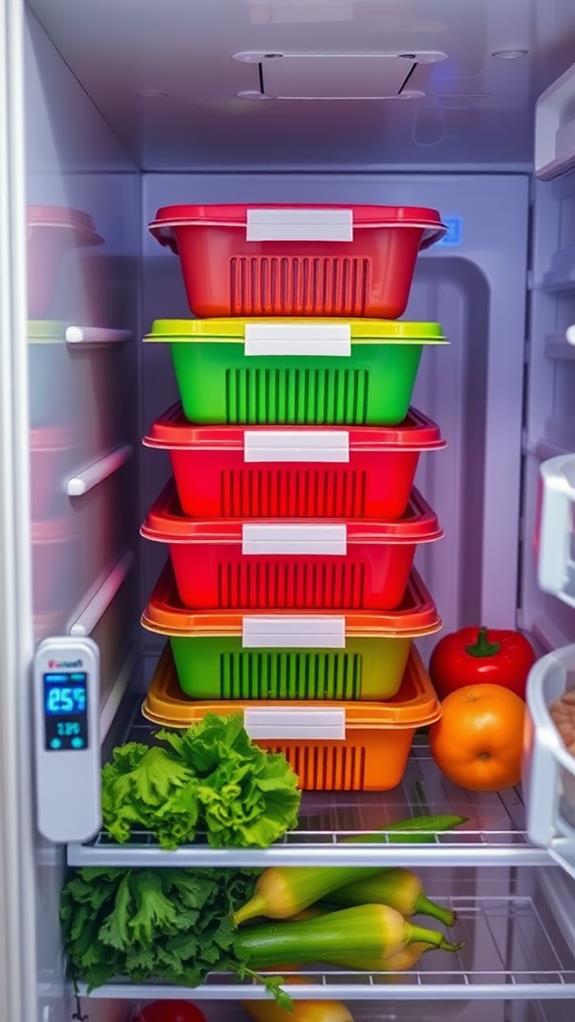Is 5 Day Old Chinese Food Safe to Eat
It's not safe to eat 5-day-old Chinese food. While proper refrigeration slows bacterial growth, it doesn't stop it entirely. The risk of foodborne illness increases considerably after 3-4 days, even with refrigeration. Pathogens like Salmonella, E. coli, and Listeria can multiply to dangerous levels in that time. You might notice signs of spoilage like off-odors, mold, or slimy textures, but harmful bacteria can be present without visible indicators. To guarantee food safety, consume your Chinese takeout within 3-4 days and always reheat it thoroughly to 165°F (74°C) before eating. If you're unsure about the safety of your leftovers, it's best to err on the side of caution and discard them. Understanding proper food storage techniques can help you maximize both safety and enjoyment.
This post may contain affiliate links. If you make a purchase through these links, I may earn a commission at no additional cost to you. Additionally, portions of this post may be generated using artificial intelligence (AI) technology. While we strive for accuracy, please be aware that AI-generated content may not always be perfect and should be fact-checked when necessary.
The Spatula Scoops
- Chinese food leftovers should be consumed within 3-4 days for optimal safety and quality.
- Proper refrigeration below 40°F is crucial to slow bacterial growth and maintain food safety.
- Signs of spoilage include off-putting odors, mold growth, discoloration, or slimy textures.
- Reheating to an internal temperature of 165°F is essential to kill potential bacteria.
- When in doubt about the safety of 5-day-old Chinese food, it's best to discard it.
Food Safety Basics

When it comes to food safety, understanding the fundamentals is indispensable. You need to know the basics to protect yourself from foodborne illnesses. First, always wash your hands thoroughly before handling food. This simple step can prevent the spread of harmful bacteria. Next, be aware of the "danger zone" – temperatures between 40°F and 140°F where bacteria multiply rapidly. Keep hot foods hot and cold foods cold to avoid this range. Bacterial growth can be surprisingly fast, with some bacteria doubling in number every 20 minutes under ideal conditions within this temperature range.
Cross-contamination is another pivotal concept. Don't let raw meats touch other foods, and use separate cutting boards for different food types. When it comes to storage, refrigerate perishable foods promptly and don't overfill your fridge, as this can prevent proper air circulation. Pay attention to expiration dates and follow the "first in, first out" rule for using stored foods.
Cooking foods to the right internal temperature is critical for killing harmful bacteria. Use a food thermometer to guarantee meats are cooked thoroughly. Finally, when in doubt, throw it out. It's better to waste a little food than risk getting sick from contaminated leftovers.
Risks of Consuming Old Takeout
Caution is paramount when considering consuming old takeout food. When you're dealing with Chinese takeout that's been sitting in your fridge for five days, you're facing several potential risks. Bacterial growth is the primary concern, as harmful microorganisms can multiply rapidly in perishable foods, even when refrigerated. Pathogens like Salmonella, E. coli, and Listeria might be present, potentially causing food poisoning symptoms such as nausea, vomiting, and diarrhea. Proper cooking techniques are vital to minimize these risks, especially when reheating leftover rice, which can harbor harmful bacteria.
The quality of the food also deteriorates over time. You'll likely notice changes in texture, flavor, and aroma. Rice, a common component in Chinese cuisine, can harbor Bacillus cereus spores, which can survive reheating and cause illness. Additionally, moisture loss can affect the food's palatability and nutritional value.
It's important to note that while proper refrigeration slows bacterial growth, it doesn't halt it completely. The "danger zone" for food (between 40°F and 140°F) allows rapid bacterial proliferation. Even if the food looks and smells fine, invisible pathogens could be present. To guarantee food safety, it's best to consume leftovers within 3-4 days and always reheat them thoroughly before eating.
Factors Affecting Chinese Food Shelf-Life

When considering the shelf-life of Chinese food, you'll need to take into account several key factors. Storage temperature and methods play a pivotal role, as proper refrigeration can dramatically extend the food's safety window. Much like tofu storage techniques, Chinese food should be refrigerated promptly and kept at temperatures below 40°F to prevent bacterial growth. Additionally, the specific ingredients and preparation techniques used in the dish will impact how long it remains edible, with some components degrading faster than others.
Storage Temperature and Methods
The refrigerator is your best friend when it comes to preserving Chinese food. You'll want to store your leftovers at 40°F (4°C) or below to slow bacterial growth. Don't leave your food out at room temperature for more than two hours, as this can lead to rapid spoilage.
When storing Chinese food, use airtight containers to prevent cross-contamination and maintain freshness. Separate different dishes to avoid flavor mixing and potential bacterial spread. If you're dealing with large portions, divide them into smaller containers for quicker cooling and easier reheating.
For ideal preservation, consider freezing your Chinese food. Most dishes can be frozen for up to three months without significant quality loss. When freezing, use freezer-safe containers or heavy-duty freezer bags, removing as much air as possible to prevent freezer burn.
When it's time to reheat, make certain your food reaches an internal temperature of 165°F (74°C) to kill any potential bacteria. Use a food thermometer to verify this temperature. Remember, proper storage and reheating methods are essential for both food safety and maintaining the quality of your Chinese leftovers.
Ingredients and Preparation Techniques
While proper storage is key, the shelf-life of Chinese food also depends heavily on its ingredients and preparation methods. You'll find that dishes with high-moisture ingredients, like vegetables or broths, tend to spoil faster than drier foods. Sauces containing dairy or eggs are particularly prone to bacterial growth, reducing their safe consumption window.
The cooking technique also plays a pivotal role. Stir-fried dishes often last longer than steamed ones due to the high heat killing more bacteria during preparation. Similarly, foods cooked with preservative ingredients like soy sauce or vinegar may have extended shelf lives.
Consider the protein source as well. Seafood dishes typically spoil faster than those made with chicken or beef. If your meal contains raw elements, like in some cold appetizers, it's best to consume these within a day or two.
Lastly, the way you've reheated the food can impact its longevity. Bringing leftovers to a high temperature throughout helps kill bacteria that may have multiplied during storage. However, frequent reheating can degrade food quality and safety, so it's best to reheat only what you'll eat immediately.
Signs of Spoiled Chinese Food
Despite its delicious appeal, Chinese food can quickly turn from a tasty treat to a potential health hazard if not properly stored or consumed within a safe timeframe. To safeguard your health, it's imperative to recognize the signs of spoiled Chinese food.
First, trust your nose. If your leftovers emit an off-putting, sour, or rancid odor, it's time to toss them. Visual cues are equally important. Look for any signs of mold growth, which can appear as fuzzy spots in various colors like green, white, or black. You'll also want to check for discoloration or a slimy texture on meat and vegetables. These are clear indicators that bacteria have begun to multiply.
Lastly, pay attention to the texture. If your noodles or rice have become excessively dry or have an unusual stickiness, it's best to err on the side of caution and discard them. Remember, when in doubt, throw it out. Your health isn't worth risking over a few bites of questionable leftovers, no matter how tempting they may be.
Safely Storing Chinese Leftovers

Proper storage is key to extending the life of your Chinese leftovers and keeping them safe for consumption. To maximize freshness, you'll want to refrigerate your leftovers within two hours of cooking or receiving them. Use shallow, airtight containers to store your food, as they allow for quicker cooling and prevent bacterial growth.
When placing containers in the fridge, guarantee they're not overcrowded. This allows for proper air circulation, maintaining a consistent temperature throughout. Set your refrigerator to 40°F (4°C) or below to slow bacterial growth effectively.
For ideal quality and safety, consume your Chinese leftovers within 3-4 days. If you can't eat them within this timeframe, consider freezing. When freezing, use freezer-safe containers or heavy-duty freezer bags, removing as much air as possible to prevent freezer burn.
Label your containers with the date of storage to keep track of freshness. When reheating, guarantee the food reaches an internal temperature of 165°F (74°C) to kill any potential bacteria. Avoid reheating leftovers more than once, as this can increase the risk of foodborne illness.
Reheating Guidelines for Chinese Takeout
Reheating Chinese takeout correctly is just as important as storing it properly. When you're ready to enjoy your leftovers, verify you're using the right methods to maintain food safety and quality. For most dishes, the microwave is a quick and convenient option. However, to prevent uneven heating and potential cold spots where bacteria can thrive, follow these steps:
- Transfer the food to a microwave-safe dish
- Spread it out evenly to promote uniform heating
- Cover the dish with a microwave-safe lid or damp paper towel
- Heat in short intervals, stirring between each cycle
For crispier items like egg rolls or dumplings, consider using your oven or toaster oven. Preheat to 350°F (175°C) and heat for about 10 minutes, flipping halfway through. If you're reheating rice, add a tablespoon of water per cup of rice to prevent drying out. For stir-fries or noodle dishes, a quick toss in a hot skillet can revive flavors and textures. Always confirm the internal temperature reaches 165°F (74°C) to kill any potential bacteria.
Frequently Asked Questions
Can I Freeze 5-Day-Old Chinese Food to Extend Its Shelf Life?
It's not advisable to freeze 5-day-old Chinese food. By this time, bacteria have likely multiplied to unsafe levels, and freezing won't eliminate them. Freezing only suspends bacterial growth; it doesn't kill existing microbes. You're better off discarding the food to avoid potential foodborne illnesses. For future reference, it's best to freeze leftovers within 3-4 days of cooking. If you want to extend shelf life, freeze your Chinese takeout immediately after it cools to room temperature.
Are Certain Chinese Dishes More Prone to Spoilage Than Others?
Just as some flowers wilt faster than others, certain Chinese dishes are more vulnerable to deterioration. You'll find that dishes with high moisture content, like soups and sauces, tend to spoil quicker. Seafood and meat dishes are also more prone to bacterial growth. On the other hand, dry dishes like fried rice or noodles may last a bit longer. It's imperative to contemplate ingredients, preparation methods, and storage conditions when evaluating a dish's shelf life. Always err on the side of prudence with perishables.
How Does MSG Affect the Shelf Life of Chinese Takeout?
MSG, or monosodium glutamate, doesn't substantially affect the shelf life of your Chinese takeout. It's primarily a flavor enhancer, not a preservative. The shelf life of your leftovers depends more on factors like temperature, moisture, and initial food quality. You'll want to focus on proper storage techniques, like refrigerating promptly and using airtight containers, to extend the life of your takeout. Remember, regardless of MSG content, it's best to consume refrigerated leftovers within 3-4 days for ideal safety and quality.
Can I Use Leftover Chinese Food in New Recipes?
You can definitely use leftover Chinese food in new recipes. It's a great way to reduce waste and create unique dishes. Consider using leftover fried rice in omelettes, or repurposing stir-fry vegetables in soups. You might transform leftover chow mein into a casserole or use excess sauce as a marinade. However, verify your leftovers are still fresh and have been properly stored. Always reheat thoroughly before incorporating into new dishes to maintain food safety standards.
Does the Type of Container Affect How Long Chinese Food Stays Fresh?
You've hit the nail on the head with this question. The container you use can indeed affect how long your Chinese food stays fresh. Airtight containers are your best bet, as they prevent air and moisture from entering, slowing down bacterial growth. Glass or high-quality plastic containers work well. Avoid using the original takeout containers, as they're not designed for long-term storage. Remember, proper refrigeration is essential regardless of the container type. Always store leftovers within two hours of cooking or reheating.
Conclusion
You've learned that consuming 5-day-old Chinese food can be risky. Remember, about 48 million Americans get foodborne illnesses annually, with many cases linked to improperly stored leftovers. Always refrigerate your takeout within two hours and consume it within 3-4 days. When in doubt, throw it out. By following proper storage and reheating guidelines, you'll substantially reduce your risk of food poisoning. Stay safe and enjoy your leftovers responsibly.





